Straight Razor Collector!
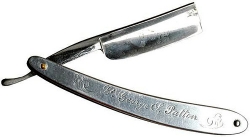
Straight razors were the most common form of shaving before the 20th century and remained that common in many countries until the 1950s. Barbers were specially trained to give customers a thorough and quick shave, and a collection of straight razors ready for use was a common sight in most barbershops.
Straight razors consist of a semi or full hollow-ground blade sharpened on one edge. The blade can be made of either stainless steel, which is slow to hone and strop but dulls more slowly, or high-carbon steel, which hones and strops quickly but requires it more often, and will rust if neglected. At present, stainless-steel razors are easy to find but expensive; carbon-steel razors are nearly as expensive but quite difficult to find.
Do you like this page?Stumble It!
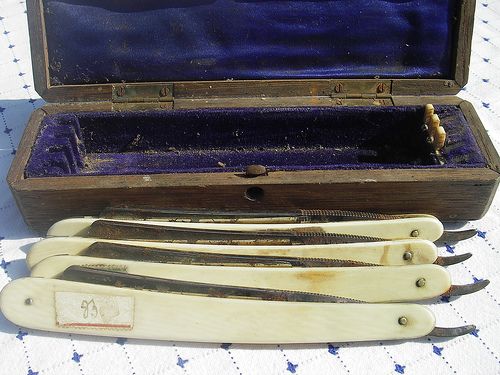
Collecting And Modern Use
Modern straight razor users are known to favor them for a variety of reasons. Some are attracted to the nostalgia of using old and traditional methods of shaving. It is a masculine ritual comparable to pipe smoking. Others profess an interest in reducing the waste of disposable blades. Still others agree that straight razors provide a superior shave through a sharper blade and greater control of the blade angle. Others simply like the good results and the satisfaction of maintaining the blade themselves. For all these reasons, devotees of the straight razor make for an active market.
Many barbers who provide straight-razor shaving now must use a version that employs a disposable blade system, as required by law in some areas. This eliminates the need for sharpening and provides greater assurance of good hygiene. (It is possible for a blade to pass infection if it cuts two customers in a row, but this is unlikely: a good barber rarely cuts a customer.) Still other jurisdictions ban the use of all straight razors and barbers use modern triple blade razors instead.
There is also an active market for antique razors in many countries, especially those in Europe and North America. Some collectors use their antique razors for shaving, but many simply collect them as memorabilia.
Straight Razor Classification
1. Point type
Blades are, at first, categorised according to point type. There are three main types of point:
Square, spike or sharp point, so called because the point profile is straight and terminates at a very sharp point perpendicular to the cutting edge of the razor. This type of blade is used for precise shaving in small areas but, at the risk of pinching the skin, it requires some experience in handling.
French (or oblique) point. Its point profile resembles a quarter circle, but with a sharper angled curve, and while it ends in a similarly sharp point as the square point it lacks the abrupt straight line edge profile. The difference between these two is mainly aesthetic.
Round point. As the name implies the point profile is semicircular and therefore it lacks any sharp end points. As such it is a more forgiving blade than the other two types and, although lacking the pinpoint accuracy of the other two, it is recommended for relatively new users. There are also secondary edge types that derive from a combination of the above such as half round point incorporating round edges joined by a linear segment.
Straight razor with square point and a double stabiliser
Straight razor with round point
2. Grinding method
The second category refers to the type of grinding method used and, since it affects the curvature of the blade cross section, includes the following two main types of blade grinds:
Flat or straight grind, indicating that the sides of the blade cross section are linear. This cross section most closely resembles a wedge and therefore this blade is sometimes called the wedge.
Hollow grind, indicating that the sides of the blade cross section are concave.
The combination of the types found in these two classification categories can, in theory, lead to a wide variety of blade types such as round point hollow ground, square point flat ground etc., but in practice some points are combined with a specific grind. As an example, a French point blade is usually flat ground.
For a blade to be most effective in cutting it must be as thin as possible. Therefore the grinding method that removes the most material from the blade, without compromising blade integrity, is to be preferred. A hollow grind produces a thinner blade than the flat grind because it removes more material from the blade (hollows or thins the blade more) and is generally considered a more effective (and expensive) method. In fact some high-end razor manufacturers limit their production exclusively to hollow ground razors.
3. Blade width
The third and final category refers to blade width. The width of the blade is defined as the distance between the back of the blade and the cutting edge. It is expressed in units of eighth of an inch. The sizes vary from 3/8" up to 7/8", rarely 8/8". A wider blade can carry more lather, much like a scoop, during multiple successive shaving strokes and thus it allows the user more shaving time and minimises blade rinse cycles. The disadvantage of the wider blade is that it is not as manoeuverable as a narrower blade. A narrow blade can shave tight facial spots such as under the nose, but it must be rinsed more often. The most popular blade width size is 5/8".
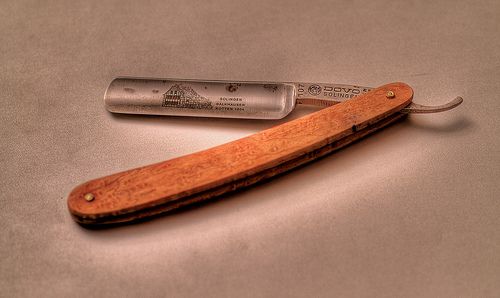
Handle Materials And Their Properties
Handle scales are made of various materials, including mother-of-pearl, bakelite, celluloid, bone, plastic, wood and tortoise shell. Celluloid can spontaneously combust at elevated temperatures. Buffalo horn tends to deform with time and it possesses form memory so it tends to warp. Mother of pearl is a brittle material and can exhibit cracks after some use.
Plastic handles are flexible and can impact the blade if not handled carefully. To remedy this, some plastic handles have a plastic coated third pin at the center called the plug that acts as a bridge between the sides of the handle.
Resin impregnated wooden handles are water resistant, do not deform and their weight complements the blade's to provide good overall balance for the razor. Snakewood is also suitable for long term and intensive use.
The mechanical properties of bone make it a good handle material. Handles were once made of ivory, but this has been discontinued, though fossil ivory, such as mammoth, is still sometimes used, and antique razors with ivory scales are occasionally found (it is illegal to kill elephants for their ivory, but it is legal to buy a razor made before 1950).
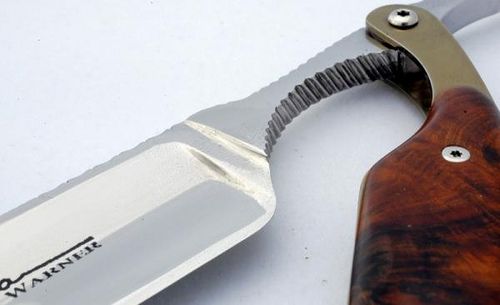
Straight Razors Construction
Straight razors consist of a semi or full hollow-ground blade sharpened on one edge. The blade can be made of either stainless steel, which is difficult to strop and hone, albeit resistant to rust, or high-carbon steel, which is much easier to hone, but stays sharp for less time, though it will rust if neglected. At present, stainless-steel razors are easy to find but expensive; carbon-steel razors are nearly as expensive but quite difficult to find. Fancy cutlery shops in shopping malls will often tell a customer that carbon-steel razors are no longer made, but they are in fact still being made, and are available on the Internet.
The blade rotates on a pin through its tang between two protective pieces called scales: when folded into the scales, the blade is protected from accidental damage, and the user is protected from accidental injury. Handle scales are made of various materials, including mother-of-pearl, celluloid, bone, plastic and wood. They were once made of ivory, but this has been discontinued, though fossil ivory is still sometimes used, and antique razors with ivory scales are occasionally found (it is illegal to kill elephants for their ivory, but it is legal to buy a razor made in 1850).
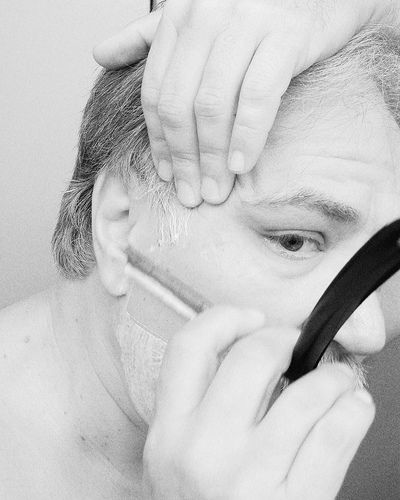
Method of Use
To be most effective, a straight razor must be kept extremely sharp. The edge is delicate, and inexpert use may bend or fold over the razor's edge. To unfold and straighten the microscopic sharp edge, one must strop the blade on a leather razor strop before every use. The blade must also be sharpened periodically by honing with a razor hone. Strops prepared with pastes containing fine grit are also used for honing but are not recommended for the inexperienced user as they can easily rake off the edge. Some strops have a linen or canvas back embedded with a fine abrasive used to maintain a sharp edge before final polishing with the leather side. A face's worth of thick hair may require multiple stroppings for one shave, but a blade is usually honed only two or three times a year. Occasional regrinding by a professional may be required to restore a badly worn or damaged edge.
Experienced straight razor aficionados often advocate stropping after each shave and allowing the blade to recover its edge for several days before reuse. Historically this necessitated a collection of several razors sometimes sold in a sets for a week's use. Shaving soap in a cup is traditionally lathered and applied using a rotating in-and-out motion of a Shaving brush, usually made of boar or badger bristles, though modern barbers are usually required by law to use other methods. The shave is completed using as few strokes as possible, honing sparingly if at all. A second shave with another razor in an alternate direction against the beard yields an extremely close shave, at the risk of producing ingrown hairs. Rinsing with cold water constricts minor abrasions or cuts, followed by patting dry (not rubbing) and an astringent or aftershave lotion. More serious nicks can be attended with direct pressure for perhaps a minute with a styptic pencil. A light steady touch is most effective at providing a close shave, preserving the edge and avoiding cuts.
In the heyday of straight razor shaving, wealthy users maintained a weekly "rotation" of seven razors to reduce wear on any one piece. Straight razors were often sold in special boxes of seven labeled for the days of the week. However, many users owned only one razor.
Shaving Gift Ideas On Amazon
If you're looking for gift ideas for someone who uses a straight razor, look no further! Click on one of these links to see item pictured and more straight razor gift ideas.
Straight Razor Pictures
While I don't have room to show a lot of pictures on this lens, I have links to some great ones.
BEAUTIFUL CELLULOID HANDLED STRAIGHT RAZORS
These links are to pages on www.rebelrazor.com, a great site for anyone collecting straight razors!
Straight Razors On YouTube
Use As A Weapon
The typical straight razor's extreme sharpness, portability, and ease of concealment has led to it being used as an illegal weapon. As a straight razor has a slashing action and not a stabbing one, it is often used to disfigure the victim of the assault. Slitting the victim's face from the corner of the mouth to the ear is called a Chelsea smile, as this was said to be a method of punishment dispensed by criminal gangs in the Chelsea area of London. The prevalence of attacks involving knives in Glasgow (Glasgow's "knife culture"), has also led to the term Glasgow smile being adopted for the same injury. Here, the colloquial name for the weapon is a malky (local rhyming slang, Malky [Malcolm] Fraser = razor), thus by extension any edged weapon so used. Slitting the throat and then pulling the tongue out is called a "Sicilian Necktie" or "Colombian necktie". The "Jester's Smile" is the term used for when a straight razor is used to unhinge the jaw and then the throat is slit. As massive blood loss occurs from such wounds, these injuries can prove fatal. If they do not, a distinctive scar is formed. Straight razors have featured in some films as both weapons and torture implements.
Stories circulate as to how gangster Al Capone got his nickname Scarface: attributing it to an irate barber, who allegedly cut him with a razor; another story says he fared poorly in a knife-fight.
Shaving cream - Ok, so you've got a straight razor. Don't you need a shaving cream?
About this site.
If you've made it this far, I'd appreciate it if you would check out Dene's Place to see if there's anything that you might like for yourself or as a gift. It helps me pay the bills!
Thanks for stopping by! Be sure to check out my other lenses when you have time.
Much of the information used here has been researched from Wikipedia, the free encyclopedia.
All text is available under the terms of the GNU Free Documentation License.

Visit our website
You're welcome to visit our travel photography website Earth in Pictures.
Vienna: Austrian Parliament | Burgtheater (Castle Theatre) | Hofburg Imperial Palace | State Opera (Staatsoper) | Stephansdom (Saint Stephen's Cathedral)
Brussels: Atomium | Berlaymont building - European Commission headquarters | Brussels City Hall | European Parliament building | Grand Place - Grote Markt | Manneken Pis statue | Royal Palace | The King's House (Maison du Roi)







